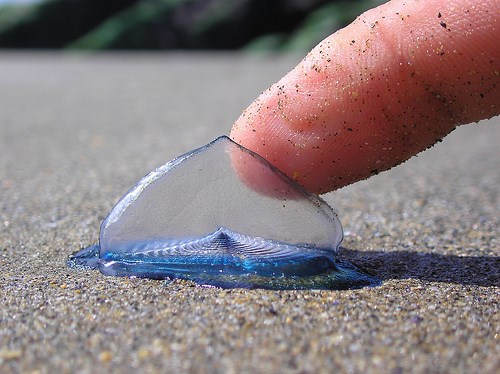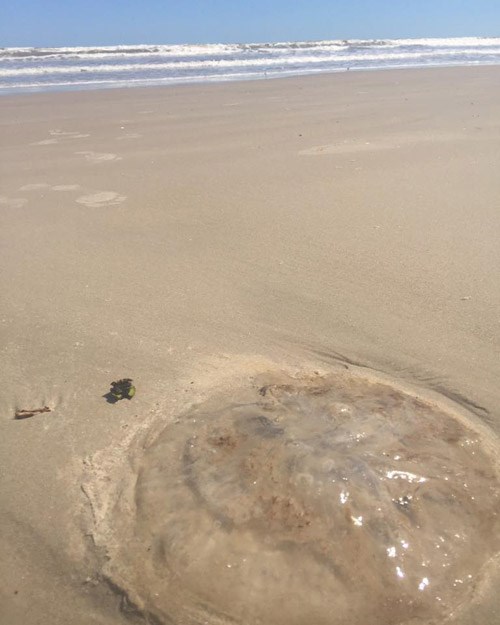
NPS Photo Sea Jellies and Jelly-like Organisms
Most people cringe when they think of jellyfish floating through the ocean or laying on the beach. In fact, the painful sting that is caused by some jellyfish has made us overlook what makes these animals so beautiful and interesting. Jellyfish serve as an important part of the food web and many animals, including birds and turtles, consider jellyfish to be a tasty treat. You can often visit the National Seashore and view shorebirds and other wildlife eating jellyfish that have washed ashore. Jellyfish are related to other creatures, such as sea anemones, corals, and hydroids. All of these creatures use stinging cells for feeding and defense. With no brain to guide their actions, jellyfish must depend on currents to carry them to where food may be. Spring and summer winds and currents can sometimes cause many jellyfish to wash onto the beach at the National Seashore.
Portuguese Man-of-War
The Portuguese man-of-war is sometimes referred to as the "blue jellyfish," but it is actually not a true jelly. Instead, it is a colony of four organisms that live and work together as a single unit. Each type of animal forms a different part of the body with one of four specialized jobs. The units of animals include the hunting and digestive polyps, the floating unit, and the animals that reproduce for the colony. In order to stay wet, this creature may rock from side to side in the water, but it can also deflate and temporarily submerge itself to avoid a surface attack. Suspended beneath the float are long tentacles, reaching up to 60 feet, with stinging cells used for capturing small fish that wander into this drifting death trap. Portuguese man-of-war have an extremely painful sting, so you may want to stay out of the water if you see many of them washed on the beach.

Photo courtesy of Melissa Duvall Blue Button
Sometimes the beach looks as though it is freckled with blue-green coins. These are Blue button jellyfish, and like the Portuguese man-of-war, each is actually a colony of organisms that drift where the wind and currents send them. Each type of animal in the colony serves a specialized function for the survival of the colony. While small, free-floating marine animals, known as zooplankton, are captured by the Blue button's tentacles, humans are fortunately unaffected by its mild sting.

NPS Photo By-the-Wind Sailor Like the Portuguese Man-of-War and Blue button, the By-the-wind sailor is a colonial organism made up of hundreds of polyps working closely together. Only a couple of inches in length, this creature consists of an oval-shaped body and sail. Its disk-like body is filled with small, gas-filled tubes that help it float. The orientation of the sail on top helps to determine which direction this jelly will travel. Located on the middle of the bottom of the disk is the mouth, into which copepods, fish eggs, and other zooplankton unknowingly drift. Fortunately, the stinging tentacles have no effect on people. 
Okeefes.org Cabbagehead Jellyfish The Cabbagehead jellyfish moves along like a bulky, milky-colored bell. Unlike the Moon jelly, the Cabbagehead jelly's bell lacks long tentacles, but has short oral arms that extend below the bell. A small number of stinging cells located on the stubby arms are used to consume mainly plankton. The Cabbagehead can, but does not usually, cause a mild tingle if touched by a human.

NPS Photo Moon Jelly
Moon jellies are clear, fragile swimmers that propel themselves through the water by moving their bell in a waving motion. Four horseshoe-shaped markings in the center of its bell are its distinguishing characteristics. Four short feeding arms extend downward from under the bell, acting as fishing lines that catch zooplankton, mollusks, and crustaceans. Although Moon jellies are relatively harmless, their sting can cause minor skin irritations if handled. Found worldwide, Moon jellies are common in the Laguna Madre during the summer.

NPS Photo Sea Nettle
Like the land plant which shares its name, the Sea nettle packs a powerful sting. Several long tentacles dangle from the edge of its bell, and four long arms are suspended from the center of the bell. Small triangles radiate outward from the center of the upper surface of the bell's edge. The color of these triangles and tentacles varies from nearly clear to pink or rust. Sea nettles are common during the summer in the Laguna Madre and can be found on the Gulf shore. Unlike many other jellyfish that eat fish or plankton, Sea nettles also eat their distant kin, known as Comb jellies (shown below).

National Geographic Comb Jelly
Comb jellies, lacking stinging cells and having a complex digestive system, are not true jellies. They derive their name from the eight comb-like structures, called cilia, that propel these animals through the water. The cilia bend light like a prism as they move, causing these jellies to glow in the dark. In the summer, many comb jellies migrate to the Laguna Madre in search of larval shrimp and oysters.
What do I do if stung by a jellyfish?
Many of the jellies that are found in the Laguna Madre or Gulf of America have stinging cells that are too weak to affect humans. Even though animals like the Portuguese man-of-war or Sea nettles can have quite a painful sting, there is seldom a need for serious medical concern unless the person stung has other allergies, such as bee stings or ant bites. If you are stung, apply salt water, not fresh water. Applying fresh water will cause the stinging cells to become agitated, resulting in further pain. You can seek medical attention at the Malaquite Visitor Center or apply vinegar to the irritated area.

NPS Photo While some things that wash ashore may appear to be trash, some are actually living creatures. Visitors frequently report finding bunches of electrical wire, but the majority of the time, what they are actually describing is the remains of a soft coral called sea whip (Leptogorgia setacea). Sea whip, or whip coral, is a colony made up of many different polyps, or tiny animals. Sea whip builds itself around a black axial rod that, when exposed, resembles electrical wire.
As you're walking the beaches of Padre Island National Seashore, be on the lookout for these tangled masses of yellow sea whip. Look carefully through the coral bundles for hidden treasures such as sand dollars, shells, and sea beans. Please make sure all shells are unoccupied and the sand dollars are dead before taking anything home.
|
Last updated: February 18, 2025
